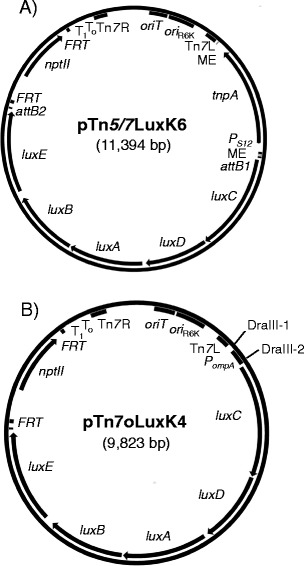Figure 5.

Maps of next generation mini-Tn 5/7 - lux and mini-Tn 7 - lux delivery vectors. A) pTn5/7LuxK6. As in pTn5/7LuxK3 (Figure 2) the mini-Tn5/7-lux element is flanked by the Tn5 mosaic ends (ME) and carries a promoter-less P. luminescens luxCDABE operon, in this example the kanamycin resistance encoding nptII gene, the Tn7 left (Tn7L) and right (Tn7R) ends, the R6K origin of replication (ori R6K), and an origin of conjugative transfer (oriT). The new generation of vectors is further functionalized by 1) transcription of the Tn5 transposase-encoding tnpA gene located outside of the transposable element by the constitutive S12 gene promoter (P S12) from Burkholderia thailandensis; 2) flanking of the antibiotic resistance marker by functional Flp recombinase target (FRT) sites; and 3) flanking of the lux operon by attB sites for Gateway recombineering. The pTn5/7LuxG6, pTn5/7LuxT6 and pTn5/7LuxTc6 contain gentamicin, trimethoprim and tetracycline resistance markers, respectively. Other abbreviations are defined in the Figure 2 legend. B) pTn7oLuxK4. This vector contains many features of the pTn5/7Lux series but does not contain the Tn5 transposase gene or mosaic ends. Its unique features include two DraIII sites that because of the 3-nucleotide ambiguity (indicated by bold letters) in the DraIII recognition sites (DraIII-1 5′-CACTATGTG and DraIII-2 5′- CACCGCGTG) can be used for directional cloning of promoter-containing DNA fragments for transcription of the lux operon genes. In the illustrated example the lux operon is transcribed from the B. pseudomallei ompA promoter (P ompA). This is also indicated by the “o” in the plasmid name. The pTn7oLuxG4 and pTn7oLuxT4 contain P ompA and the gentamicin (aacC1) and trimethoprim (dhfRII) resistance markers, respectively. Other abbreviations are as in A).
